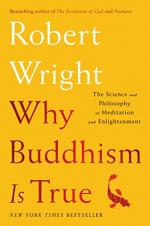|
This section contains 747 words (approx. 2 pages at 400 words per page) |

|
Why Buddhism Is True: The Science and Philosophy of Meditation and Enlightenment Summary & Study Guide Description
Why Buddhism Is True: The Science and Philosophy of Meditation and Enlightenment Summary & Study Guide includes comprehensive information and analysis to help you understand the book. This study guide contains the following sections:
This detailed literature summary also contains Topics for Discussion on Why Buddhism Is True: The Science and Philosophy of Meditation and Enlightenment by Wright, Robert.
The following version of this book was used to create the guide: Wright, Robert. Why Buddhism Is True: The Science and Philosophy of Meditation and Enlightenment. Simon & Schuster, 2017.
Many Western Buddhists identify with the movie The Matrix, due to its message that the world the protagonist is living in is actually a hallucination. A book that Robert Wright once wrote about the effect that natural selection has on everyday decisions was actually given to the actor playing the protagonist for that movie. In the book, Wright had written about the way natural selection does not aim to provide an environment conducive to happiness— rather, it only aims to guarantee one’s survival and reproduction.
An example of an illusion that natural selection provides is the urge to eat junk food, though it is only a temporary pleasure that leads to a crash in energy later. Mindfulness meditation is a Buddhist practice that is meant to eventually liberate a person from a life filled with these illusions. Wright attended a meditation retreat and was able to dissolve a physical pain simply through the way he paid attention to it.
Rather than having inherent meaning, emotions are another illusion used as a tool for natural selection’s goals. Organisms feel positive feelings toward something when approaching that thing would help the organism survive or reproduce; They feel negative feelings when avoiding something would help the organism survive or reproduce. A prominent example of this is a fear of public speaking, as a blunder during a public speech could be dangerous for one’s reputation in a hunter-gatherer society. However, today, it does not matter as much for one’s survival.
Meditation can lead to moments of overwhelming bliss or a generally heightened perception of beauty. Meditation retreats are meant to foster these, and eventually meditation should lead to a state of enlightenment. The Buddha explained that no part of the self is under one’s control, nor is any part permanent. Thus, the belief of not-self is a part of Buddhist enlightenment. This state cannot reached by intellectual thought alone, it requires experiential learning in the form of meditation.
Most decisions made by a person are actually made by modules in the brain. These are networks that natural selection designated to be in control of specific tasks, such as feeling jealous or recognizing loved ones. The conscious brain is in charge of little to no thinking, but it is under the impression that it is. This is for the purpose of communication, and seeming competent to others if asked about one’s decisions.
The mind wanders in accordance with these modules, suggesting that the mind does not choose to wander. Instead, the modules are creating the thoughts. Each thought will be accompanied by a feeling, and the best way to create mental distance from a thought is to create mental distance from the feeling first. Self-control is difficult, but becoming less attached to one’s feelings is the best way to reduce urges with negative results.
Another central concept in Buddhist philosophy is formlessness, which says that nothing in the world contains inherent meaning. Though this may sound bleak, it can help a person reconstruct the world in a happier, more positive way. The essence of any object may simply be the feelings it may give a viewer, as every object has at least a subtle positive or negative association. One can also reduce the impact of these negative associations through loving-kindness meditation.
Formlessness, also referred to as emptiness, seems to contrast with the idea that everything is one. Wright argues that this is not a paradox— instead, the distance between the self and the external world should be reduced until they are one. Everything is formless, as nothing is self-sufficient. These beliefs can lead one to enlightenment, also called nirvana. In this state, one frees itself from the causal links of the world and the bigger cycle of endless rebirth. The pursuit of enlightenment coincides with the pursuit of metaphysical truth and moral virtues.
Wright’s most powerful meditative experience included colorful visuals. During it, he saw that the self-critical voice in his head was not truly a part of his self. Since then, he has meditated every day, as well as written this book. Though he was raised as a Southern Baptist and now considers himself not to have a religion rather than considering himself to be Buddhist, he believes in the power of meditation.
Read more from the Study Guide
|
This section contains 747 words (approx. 2 pages at 400 words per page) |

|



